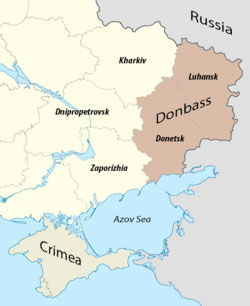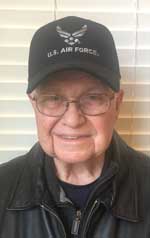Background on the Ongoing Turmoil in Eastern Ukraine

The divided ethnic loyalties in Donbass escalated into sporadic warfare in March 2014 following pro-Western demonstrations in Kiev and the Russian Federation’s re-annexation of the Crimean Peninsula, which it had previously ceded to Ukraine in 1954 as a gesture of Russian-Ukrainian unity. This was confirmed by a friendship treaty in 1997. About 14,000 people have been killed since the Donbass War began in 2014.
Ukraine is the second poorest country in Europe and reputedly the most corrupt. Geographically it borders Russia, the Sea of Azov, the Black Sea, Moldavia, Romania, Hungary, Slovakia, Poland, and Belarus.
Ukraine had been racked by political turmoil since the 2004 Ukrainian presidential election. The source of the turmoil was over whether Ukraine should become a member of the European Union and a member of NATO. Russia strongly objected. Pro-Russian Viktor Yanukovych was elected president after two rounds of voting, but pro-Western Viktor Yushchenko backers protested that the election results were fraudulent and staged huge protests in Kiev. This was called the “Orange Revolution.” The United States, the EU, and George Soros backed Yushchenko’s Orange revolution. The Ukrainian Supreme Court ruled for a new election, which Yushchenko won with 52 percent of the vote. The Donbass region threatened to secede. Yushchenko’s term in office, however, proved unsatisfactory to the Ukrainian Parliament and Ukrainian voters, and pro-Russian Yanukovych was elected president in 2010.
In November 2013, Yanukovych scuttled a proposed economic agreement with the EU just days before it would become effective, because of Russian pressures, which led to huge protests in Maidan (Independence) Square in Kiev. Harsh measures were used to break up the protests.
Pro-Western calls for Yanukovych’s resignation refueled and increased tension in the Donbass region and helped spark the beginning of the Donbass War.
In May 2014, billionaire pro-Western Petro Poroshenko was elected president with 54 percent of the vote. It was in mid-2014 that Hunter Biden became a board member of the large and corrupt Burisma natural gas company. As Vice President, Joe Biden visited Ukraine five times between 2014 and 2017. In February 2015, Ukraine, Russia, Germany, and France brokered a peace agreement on Donbass that held until recently. Poroshenko, however, was discredited by discovered corruption in 2016. It was in December 2015 that Joe Biden threatened to deny a badly needed $1.0 billion loan from the U.S. to Ukraine unless they fired Ukrainian Prosecutor General Viktor Shokin, who had been investigating corruption since his appointment in February 2015. Pressure to fire Shokin was supported by the EU, International Monetary Fund, and the World Bank, allegedly for failure to investigate Poroshenko. His dismissal was officially ratified by Parliament in March 2016, but it is still in the Ukrainian court system. An attempt to poison Shokin with mercury while visiting Greece in September 2020 is being investigated by Greek authorities. The mercury poisoning has been confirmed by his Austrian doctors.
In April 2019, Volodymyr Zelensky, a popular TV personality and comedian, was elected president with a 73 percent landslide.
Russian President Vladimir Putin has been in office since 2012 and served a previous term as president from 1999 to 2008. Born in St. Petersburg in 1952, he graduated with a degree in law in 1975 from Leningrad State University. He served 16 years as an intelligence officer with the KGB and reached the rank of Lt. Col., but resigned in begin a political career in St. Petersburg in 1991, when the Soviet Union collapsed. He joined the administration of Russia’s first president, Boris Yeltsin, in 1996. Yeltsin was an independent reformer favoring more economic freedom, privatization of industry, and greater autonomy for the Russian Federation’s republics. Putin was also reform minded and was appointed Director of the Federal Security Service and Secretary of the Security Council. He was appointed prime minister in 1999 and became acting president on Yeltsin’s resignation December 31, 1999. Putin is not a communist; he is an economic reformer. Primarily he is a Russian nationalist who would have liked to have included all the former Soviet Republics into the new Russian Federation. Putin was secretly baptized in the Russian Orthodox Church as a child and has supported the expansion of Russian Orthodoxy in the Russian Federation. His economic reforms have been very successful. During his first 8 years as president, the Russian GDP grew by 72 percent and more than tripled real wages. GDP growth has slowed since then and fell 3.7 percent in 2015 because of the Donbass War. Putin was re-elected with 64 percent of the vote in 2012 and 76 percent in 2018 for another 6-year term. He managed to get the Russian Constitution changed so that he could, if elected, serve two more terms until 2036.
Ukraine was part of the Soviet Union until the Ukrainians declared their independence in 1991, following the breakup of the Soviet Union. Ukraine has been part of the Russian Empire since Catherine II the Great consolidated it into the Russian Empire in 1764. Following the Russian Revolution in 1917 and several years struggling for independence, Ukraine became a Soviet Republic in 1922. Ukrainians suffered greatly under Soviet leader Joseph Stalin. In 1932-1933, an estimated 3.9 million Ukrainians died of starvation or were summarily executed when Stalin wanted to replace Ukraine’s small farms with state-run collectives and punish independence-minded Ukrainians who posed a threat to his totalitarian authority. However, 4.5 million Ukrainians fought fiercely in the Soviet Army against the Germans from 1941 to 1945. Approximately 1.4 million were killed in service fighting the Nazis.
Both the Russians and the Ukrainians suffered tremendously under Stalin and in the “Great Patriotic War” (World War II) against the Germans. The Russian Ministry of Defense has estimated that Soviet military dead totaled nearly 8.7 million, and civilian dead totaled 17.9 million, yielding total Soviet military and civilian dead at 26.6 million. Donbass is significant. Many costly wars have erupted from smaller beginnings.
According to an April 1 Reuters news service release, Russian President Vladimir Putin stated that “Those who try to start a new war in Donbass—will destroy Ukraine.” The NATO and American view is, however, that it is the Russians who are escalating the tensions. Several Ukrainian soldiers have been killed in the last week. Ukrainian intelligence sources “have not ruled out the advance of Russian occupation sources deep into Ukraine.” EU and NATO officials are making strong statements in support of Ukraine. U.S. Secretary of Defense Lloyd Austin “condemned recent escalations of Russian aggressive and provocative actions in eastern Ukraine.”
One Ukrainian report indicated that para-military units of the Don Cossacks were also gathering just east of the border. The Russians have been using Cossacks (Russian: Kazak) in border defense units. The Kazaks have a reputation for being among the best soldiers in the world, and are famous for their horsemanship and swift swords. Ukraine is mostly level “steppe” lands, ideal for horses and tanks. The Russians have 13,000 modern tanks. The Ukrainians, who have Kazaks of their own, have just over 2,400 tanks. The Russians also have a 4 to 1 heavy artillery advantage. The Russians have 538 attack helicopters versus 34 for Ukraine. Ukraine has a relatively large active military for its population, 255,000, versus 1.1 million for the Russian Federation. The Russians have over 2,700 combat aircraft versus only 67 for Ukraine. The Ukrainian Navy is very small, whereas the Russians have 111 combat surface ships, 63 submarines, and an aircraft carrier. This is not an even match without outside help.
Russia is the second most powerful military force in the world. The United States is first, and China is third. Ukraine is the 25th largest.
Russian aggressive actions in eastern Ukraine and Chinese threats against Taiwan are opportunistic probes to test the Biden Administration’s will to defend its foreign policy and defense commitments. They come just as Biden is allowing our Southern border to be breached by hundreds of thousands of illegal immigrants, including terrorists, Mexican drug cartels, enemy infiltrators, and Covid carriers. They come just as the Biden Administration is slashing military budgets, politicizing our military with leftist woke doctrines, and demoralizing and purging patriots deemed “white supremacists” based on Marxist critical race theory and Marxist corrupted theories of social justice, which are in strong contradiction to Biblical and traditional American concepts of justice. We live in perilous times where cultural discernment and strong hearts are necessary for survival.









 Mike Scruggs is the author of two books: The Un-Civil War: Shattering the Historical Myths; and Lessons from the Vietnam War: Truths the Media Never Told You, and over 600 articles on military history, national security, intelligent design, genealogical genetics, immigration, current political affairs, Islam, and the Middle East.
Mike Scruggs is the author of two books: The Un-Civil War: Shattering the Historical Myths; and Lessons from the Vietnam War: Truths the Media Never Told You, and over 600 articles on military history, national security, intelligent design, genealogical genetics, immigration, current political affairs, Islam, and the Middle East. 


